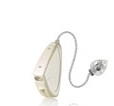 Individuals relying on traditional earbuds or headphones to listen to music with only one ear often complain about sound quality. In this situation, using a typical mono and/or stereo earbud in one ear rather than two results in the loss of one of the two channels, providing the user with essentially only half of the music rather than enabling the user to experience full stereophonic sound. This is an issue not only for people with hearing loss in only one ear, but for normal hearing cyclists, runners, snowboarders, and other active individuals who, for safety reasons, want to keep one ear unplugged so they can hear their surroundings. A new product called One Good Earbud offers patients, active individuals, and/or athletes a viable solution.
Individuals relying on traditional earbuds or headphones to listen to music with only one ear often complain about sound quality. In this situation, using a typical mono and/or stereo earbud in one ear rather than two results in the loss of one of the two channels, providing the user with essentially only half of the music rather than enabling the user to experience full stereophonic sound. This is an issue not only for people with hearing loss in only one ear, but for normal hearing cyclists, runners, snowboarders, and other active individuals who, for safety reasons, want to keep one ear unplugged so they can hear their surroundings. A new product called One Good Earbud offers patients, active individuals, and/or athletes a viable solution.
One Good Earbud mixes both channels of stereo together for audio devices into one ear, providing stereo quality sound through a single earbud. For individuals with single-sided deafness (SSD) or significant hearing loss in one ear, this product allows users to enjoy fuller sound. For cyclists, runners, and other athletes with normal hearing, One Good Earbud offers an ideal way to listen to music in stereo via one ear while maintaining auditory alertness in the environment with the unplugged ear. One Good Earbud is available in left and right ear versions, items EHL and EHR respectively.




















 The transmission range of the TeleView Wireless Video Otoscope is approximately 33 feet (10 meters) in direct sight. The lithium ion battery housed in the handpiece will last for approximately 90 minutes of continuous use when fully charged. The battery can be recharged by connecting the handpiece to either the USB port of the wireless receiver, the USB port found on any computer, or to a wall outlet (via USB AC adapter and silver USB recharging cable packaged with device). The battery life is approximately 300 recharges; if the battery is recharged every other day, it will last about 1-2 years. It comes packaged with reusable specula (3mm, 4mm, and 5.5 mm). A wired version of this product (model EV400) is also available.
The transmission range of the TeleView Wireless Video Otoscope is approximately 33 feet (10 meters) in direct sight. The lithium ion battery housed in the handpiece will last for approximately 90 minutes of continuous use when fully charged. The battery can be recharged by connecting the handpiece to either the USB port of the wireless receiver, the USB port found on any computer, or to a wall outlet (via USB AC adapter and silver USB recharging cable packaged with device). The battery life is approximately 300 recharges; if the battery is recharged every other day, it will last about 1-2 years. It comes packaged with reusable specula (3mm, 4mm, and 5.5 mm). A wired version of this product (model EV400) is also available.